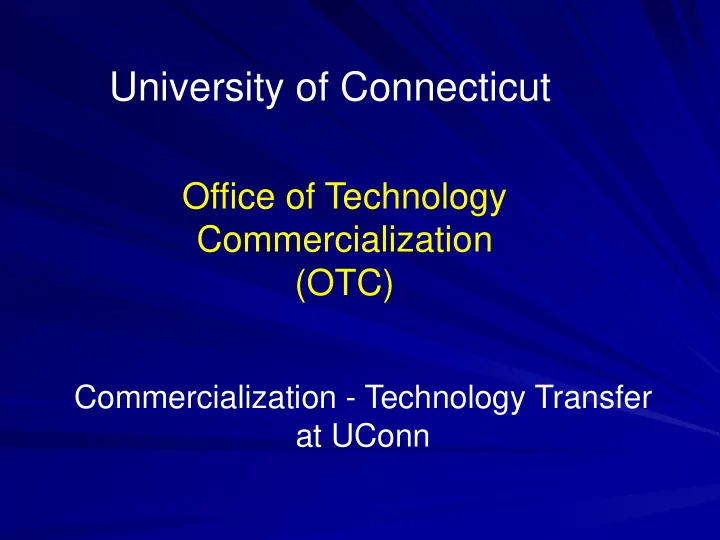

University of Connecticut Office of Technology Commercialization (OTC) Commercialization - Technology Transfer at UConn
Why Commercialize? Inventor: – To see invention used – To obtain research support and personal reward University: – To benefit the public – To reward, retain and recruit faculty – To contribute to CT’s economic development Federal Government: – To see the taxpayers benefit from their tax dollars Commercial Partner: – To obtain a commercial advantage
How is it done? Research, research, research Invention disclosure Patent, if warranted Market License Collect and distribute revenue
Obligation to disclose inventions C.G.S., Sec. 10a – 110b (State Law) … – the employee is obligated, by reason of his employment to disclose his invention fully and promptly to assign to the university his entire right, title and interest to give all reasonable aid in the prosecution of patent applications… – the university is obligated to share with the inventor 20% of net revenue derived therefrom Bayh-Dole Act (Federal Law) – The university by reason of accepting federal research money is obligated to require its faculty and technical staff to disclose and assign inventions.
Revenue Share: 1/3, 1/3, 1/3 After patent and legal fees Inventor(s) 33.3% Inventor's Research 16.6% Inventor's Department 10% Inventor's Dean 6.7% University 33.3%
Money Distributed Over the Last 5 Years Gross Revenues $5,453,000 Net Revenues $3,456,000 To Inventors $1,210,000 For Research $866,000
Who’s involved? CSTC ( http://otc.uconn.edu/cstc; 860-679-8800) Donna Cyr, Ph.D. Chemist - Physical Sci (860-679-8185) Mansoor Khan, Ph.D. – Computer Sci Eng. (860-679-8772) Gregory Gallo, Ph.D. Molecular Biologist – Life Sci Charles Goodwin, Ph.D. Biochemist, Patent Agent Michael Newborg, Ph.D. Immunologist Margaret Genest, Program Coordinator Pamela Toman, Fiscal Assistant
Criteria for Commercialization Technically sound Relevant market size An enforceable intellectual property position A prototype or proof of principle exists A Commercial partner has been identified An established company, or A start-up
DRAFT President Michael J. Hogan DRAFT UNIVERSITY OF CONNECTICUT Advisor to Office of Technology Commercialization OTC Ian Hart (25%) Suman Singha Director Industrial Vice President for Research and Graduate Education Initiatives Manages a continuum of commercialization services; supports University’s commitment to economic development by developing new initiatives to support technology transfer and technology based economic development. Center for Science and UConn Research and UConn Tech-Knowledge Portal UConn Technology Technology Commercialization Development Corporation John Hanson, Program Director Incubation Program Board of Directors Michael Newborg, Executive Director Rita Zangari, Liaison for CT entrepreneurs and Mark Van Allen, President Executive Director businesses to access the technical Invention Evaluation capacity of UConn; facilitates, Patenting Formation of new companies Incubation space and services at faculty and student support Licensing based on UConn Storrs, Avery Point and Farmington of venture growth programs. Intellectual Property Management Intellectual Property Donna Cyr , Director Alexandra Litor James Heym Graduate Charles Goodwin, Director Physical Sciences and Associate Director Senior Director Assistant Patent Agent CMBE, ME, C&EE Graduate Lisa Pichnarcik Assistant Gregory Gallo, Director Mansoor Khan, Director Research Admin Asst. Life Sciences EE & Computer Science Margaret Genest Pamela Toman Admin. Program Admin. Fiscal Asst. Coordinator
License Terms Exclusive/non-exclusive Worldwide/territories All fields of use/restricted fields of use License fees - upfront, annual/milestones Royalties - earned, minimum/sublicense share Know-how, improvements Due diligence Equity Ownership
Examples of Licensees Large Cap Small/Medium Start-ups Cap Boston ImCorp OPEL Scientific Air Products Halozyme MakScientific Therapeutics Syngenta Wellstat Focal Point Therapeutics Microsystems FMC Corp Wolfram UConn R&D Research Corporation
Recommend
More recommend